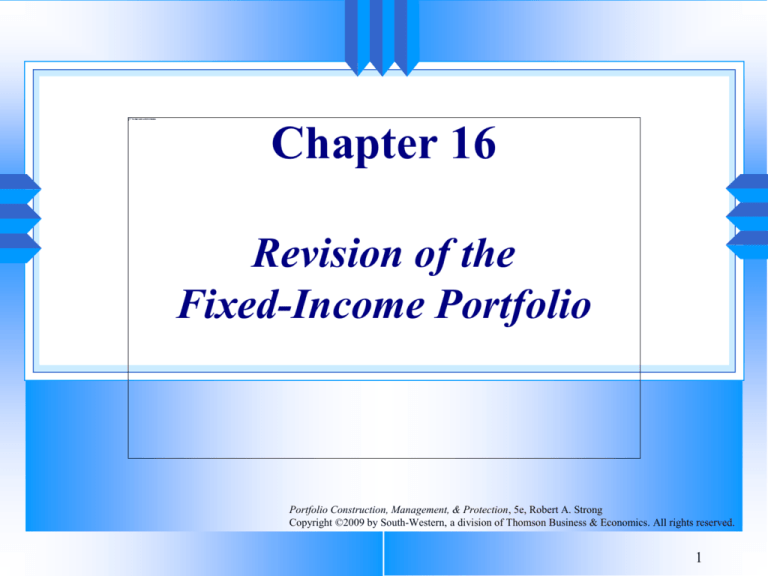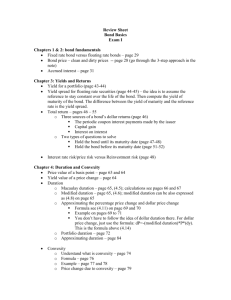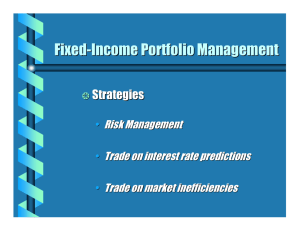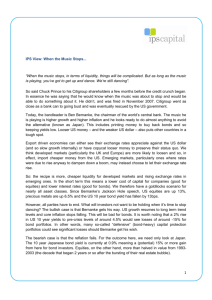
Chapter 16
Revision of the
Fixed-Income Portfolio
Portfolio Construction, Management, & Protection, 5e, Robert A. Strong
Copyright ©2009 by South-Western, a division of Thomson Business & Economics. All rights reserved.
1
There are no permanent changes because change
itself is permanent. It behooves the industrialist to
research and the investor to be vigilant.
Ralph L. Woods
2
Introduction
Fixed-income
security management is
largely a matter of altering the level of risk
the portfolio faces:
• Interest rate risk
• Default risk
• Reinvestment rate risk
Interest
rate risk is measured by duration
3
Passive Strategies
Buy
and Hold
• A passive bond strategy still requires the
periodic replacement of bonds as they mature
Indexing
• An attempt to replicate the investment
characteristics of a popular measure of the bond
market, such as:
– Salomon Brothers Corporate Bond Index
– Lehman Brothers Long Treasury Bond Index
4
Indexing and Market Efficiency
The
rationale for indexing is market
efficiency
• Managers are unable to predict market
movements and attempts to time the market are
fruitless
A
portfolio should be compared to an index
of similar default and interest rate risk
5
Active Strategies
Laddered
Portfolio
Barbell Portfolio
Other Active Strategies
6
Laddered Portfolio
In
a laddered strategy, the fixed-income
dollars are distributed throughout the yield
curve
A laddered strategy eliminates the need to
estimate interest rate changes
For example, a $1 million portfolio invested
in bond maturities from 1 to 25 years (see
next slide)
7
Par Value Held ($)
Laddered Portfolio (cont’d)
50,000
45,000
40,000
35,000
30,000
25,000
20,000
15,000
10,000
5,000
0
1
3
5
7
9
11
13
15
Years Until Maturity
17
19
21
23
25
8
Barbell Portfolio
The barbell strategy differs from the laddered
strategy in that less amount is invested in the
middle maturities
For example, a $1 million portfolio invests
$70,000 par value in bonds with maturities of one
to five and twenty-one to twenty-five years, and
$20,000 par value in bonds with maturities of six
to twenty years (see next slide)
9
Par Value Held ($)
Barbell Portfolio (cont’d)
50,000
45,000
40,000
35,000
30,000
25,000
20,000
15,000
10,000
5,000
0
1
3
5
7
9
11
13
15
Years Until Maturity
17
19
21
23
25
10
Barbell Portfolio (cont’d)
Managing a barbell portfolio is more complicated
than managing a laddered portfolio
Each year, the manager must replace two sets of
bonds:
• The one-year bonds mature, and the proceeds are used
to buy 25-year bonds
• The twenty-one-year bonds become twenty-year bonds,
and $50,000 par value are sold and applied to the
purchase of $50,000 par value of five-year bonds
11
Other Active Strategies
Identify
bonds that are likely to experience
a rating change in the near future
• An increase in bond rating pushes the price up
• A downgrade pushes the price down
12
Risk of Barbells and Ladders
Interest
Rate Risk
Reinvestment Rate Risk
Reconciling Interest Rate and Reinvestment
Rate Risks
13
Interest Rate Risk
Duration
The
increases as maturity increases
increase in duration is not linear
• Malkiel’s theorem about the decreasing
importance of lengthening maturity
• e.g., the difference in duration between twoand one-year bonds is greater than the
difference in duration between twenty-five- and
twenty-four-year bonds
14
Reinvestment Rate Risk
The barbell portfolio requires a reinvestment each
year of $70,000 in par value
The laddered portfolio requires the reinvestment
each year of $40,000 in par value
Declining interest rates favor the laddered strategy
Rising interest rates favor the barbell strategy
15
Reconciling Interest Rate and
Reinvestment Rate Risks
The
general risk comparison:
Rising Interest Rates
Falling Interest Rates
Interest Rate Risk
Barbell favored
Laddered favored
Reinvestment Rate Risk
Barbell favored
Laddered favored
(This assumes the duration of the laddered portfolio is greater than the duration of the barbell portfolio.)
16
Reconciling Interest Rate and
Reinvestment Rate Risks (cont’d)
The
relationships between risk and strategy
are not always applicable:
• It is possible to construct a barbell portfolio
with a longer duration than a laddered portfolio
– e.g., include all zero coupon bonds in the barbell
portfolio
• When the yield curve is inverting, its shifts are
not parallel
– A barbell strategy is safer than a laddered strategy
17
Bullets versus Barbells
A bullet strategy is one in which the bond
maturities cluster around one particular maturity
on the yield curve
It is possible to construct bullet and barbell
portfolios with the same durations but with
different interest rate risks
• Duration only works when yield curve shifts are
parallel
18
Bullets versus
Barbells (cont’d)
A
heuristic on the performance of bullets
and barbells:
• A barbell strategy will outperform a bullet
strategy when the yield curve flattens
• A bullet strategy will outperform a barbell
strategy when the yield curve steepens
19
Bond Swaps
In a bond swap, a portfolio manager exchanges an
existing bond or set of bonds for a different issue
Bond swaps are intended to:
• Increase current income
• Increase yield to maturity
• Improve the potential for price appreciation with a
decline in interest rates
• Establish losses to offset capital gains or taxable
income
20
Substitution Swap
In
a substitution swap, the investor
exchanges one bond for another of similar
risk and maturity to increase the current
yield
• e.g., selling an 8 percent coupon for par and
buying an 8 percent coupon for $980 increases
the current yield by 16 basis points
21
Substitution Swap (cont’d)
Profitable
substitution swaps are
inconsistent with market efficiency
Obvious
opportunities for substitution
swaps are rare
22
Intermarket or
Yield Spread Swap
The
intermarket or yield spread swap
involves bonds that trade in different
markets
• e.g., government versus corporate bonds
Small
differences in different markets can
cause similar bonds to behave differently in
response to changing market conditions
23
Intermarket or
Yield Spread Swap (cont’d)
In
a flight to quality, investors become less
willing to hold risky bonds
• As investors buy safe bonds and sell more risky
bonds, the spread between their yields widens
Flight
to quality can be measured using the
confidence index
• The ratio of the yield on AAA bonds to the
yield on BBB bonds
24
Bond-Rating Swap
A
bond-rating swap is really a form of
intermarket swap
If
an investor anticipates a change in the
yield spread, he can swap bonds with
different ratings to produce a capital gain
with a minimal increase in risk
25
Rate Anticipation Swap
In
a rate anticipation swap, the investor
swaps bonds with different interest rate
risks in anticipation of interest rate changes
• Interest rate decline: swap long-term premium
bonds for discount bonds
• Interest rate increase: swap discount bonds for
premium bonds or long-term bonds for shortterm bonds
26
Forecasting Interest Rates
Few
professional managers are consistently
successful in predicting interest rate
changes
Managers
who forecast interest rate changes
correctly can benefit
• e.g., increase the duration of a bond portfolio if
a decrease in interest rates is expected
27
Bond Convexity (Advanced Topic)
Convexity
is the difference between the
actual price change in a bond and that
predicted by the duration statistic
In
practice, the effects of convexity are
minor
28
Bond Convexity (cont’d)
The
first derivative of price with respect to
yield is negative
• Downward sloping curves
The
second derivative of price with respect
to yield is positive
• The decline in bond price as yield increases is
decelerating
• The sharper the curve, the greater the convexity
29
Bond Price
The Importance
of Convexity (cont’d)
Greater Convexity
Yield to Maturity
30
Bond Convexity (cont’d)
As
a bond’s yield moves up or down, there
is a divergence from the actual price change
(curved line) and the duration-predicted
price change (tangent line)
• The more pronounced the curve, the greater the
price difference
• The greater the yield change, the more
important convexity becomes
31
Bond Price
The Importance
of Convexity (cont’d)
Error from using
duration only
Current bond
price
Yield to Maturity
32
Calculating Convexity
The
percentage change in a bond’s price
associated with a change in the bond’s yield
to maturity:
dP 1 dP 1 d 2 P
Error
2
dR 2 (dR )
P P dR 2 P dR
P
where P bond price
R yield to maturity
33
Calculating Convexity (cont’d)
The
second term contains the bond
convexity:
1 d 2P
Convexity
2 (dR 2 )
2 P dR
34
Calculating Convexity (cont’d)
Modified
duration is related to the
percentage change in the price of a bond for
a given change in the bond’s yield to
maturity
• The percentage change in the bond price is
equal to the negative of modified duration
multiplied by the change in yield
35
Calculating Convexity (cont’d)
Modified
duration is calculated as follows:
Macaulay duration
Modified duration
1 Annual yield to maturity / 2
36
General Rules of Convexity
There
are two general rules of convexity:
• The higher the yield to maturity, the lower the
convexity, everything else being equal
• The lower the coupon, the greater the
convexity, everything else being equal
37
Using Convexity
Given
a choice, portfolio managers should
seek higher convexity while meeting the
other constraints in their bond portfolios
• They minimize the adverse effects of interest
rate volatility for a given portfolio duration
38









